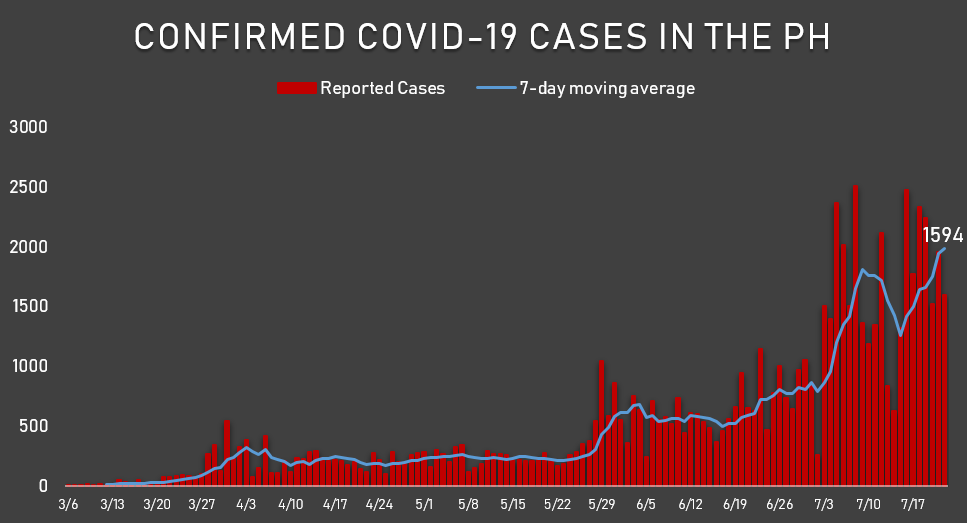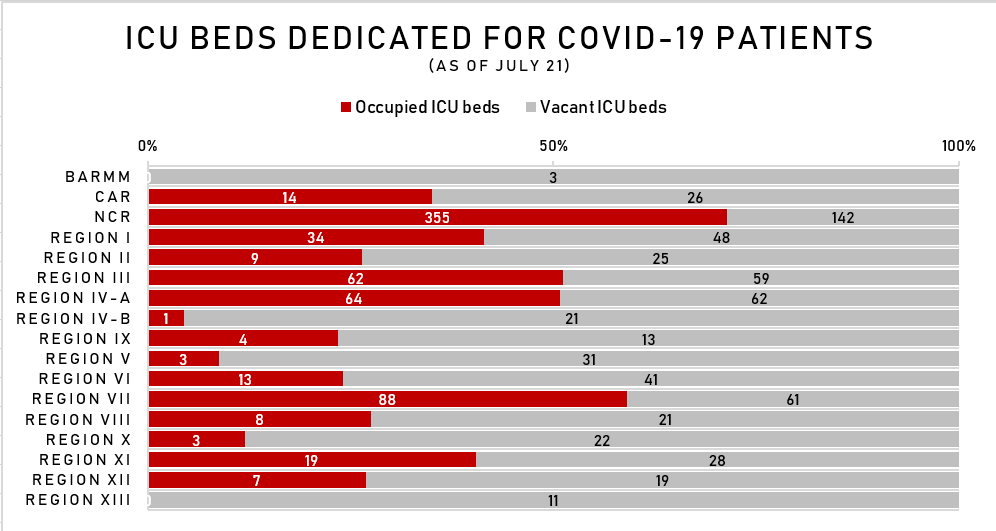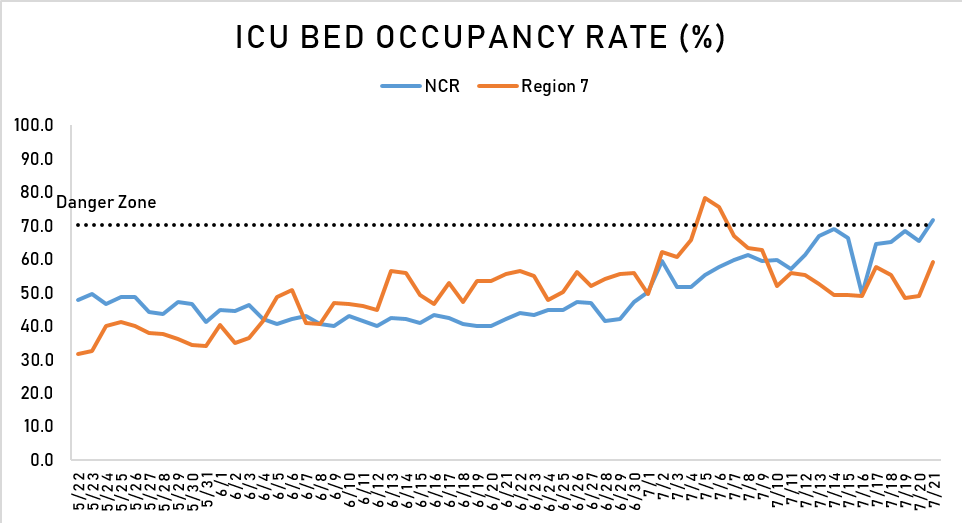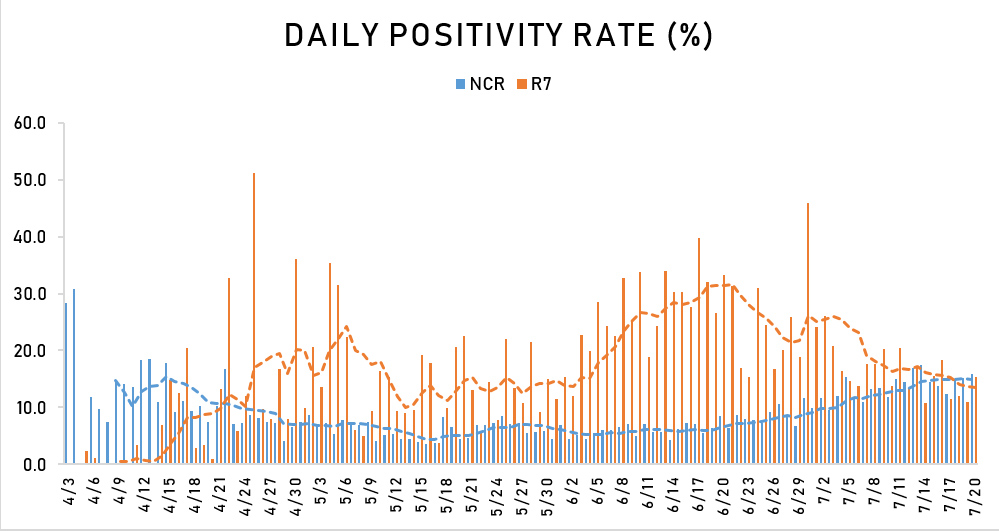NCR positive cases, ICU bed occupancy rise to dangerous levels, offsetting gains made vs COVID-19 in Central Visayas | ABS-CBN

Welcome, Kapamilya! We use cookies to improve your browsing experience. Continuing to use this site means you agree to our use of cookies. Tell me more!
NCR positive cases, ICU bed occupancy rise to dangerous levels, offsetting gains made vs COVID-19 in Central Visayas
NCR positive cases, ICU bed occupancy rise to dangerous levels, offsetting gains made vs COVID-19 in Central Visayas
Warren de Guzman and Edson Guido,
ABS-CBN News
Published Jul 23, 2020 05:45 PM PHT
MANILA -- President Rodrigo Dutere will once again decide on what to do with current quarantine conditions across the Philippines at the end of July. The ABS-CBN Data Analytics Team has been monitoring the numbers, and there are some key developments involving outbreak ground zero in the Philippines, the National Capital Region(NCR), and hottest hotspot outside of Luzon, Central Visayas.
MANILA -- President Rodrigo Dutere will once again decide on what to do with current quarantine conditions across the Philippines at the end of July. The ABS-CBN Data Analytics Team has been monitoring the numbers, and there are some key developments involving outbreak ground zero in the Philippines, the National Capital Region(NCR), and hottest hotspot outside of Luzon, Central Visayas.
The daily cases reported from the NCR are staggering, with positive totals confirmed by DOH hitting over 1,000 cases for six straight days before levelling off at 971 cases on July 22. Of the 13,780 cases reported in the past week, 9,952 or 72% came from the NCR. That’s a total of nearly 10,000 cases in just one week, helping to push the Philippine total to over 70,000.
The daily cases reported from the NCR are staggering, with positive totals confirmed by DOH hitting over 1,000 cases for six straight days before levelling off at 971 cases on July 22. Of the 13,780 cases reported in the past week, 9,952 or 72% came from the NCR. That’s a total of nearly 10,000 cases in just one week, helping to push the Philippine total to over 70,000.
The latest data on confirmed COVID-19 cases show no evidence of a flattening curve in the viral outbreak in the NCR. The blue 7-day moving average for the region shown in this chart is shooting up. The red bar graphs representing new cases confirmed everyday are dominating the black background of the chart in July. The evidence points to increased transmission of the virus after the lifting of stringent quarantine conditions in the most important economic hub of the Philippines.
The latest data on confirmed COVID-19 cases show no evidence of a flattening curve in the viral outbreak in the NCR. The blue 7-day moving average for the region shown in this chart is shooting up. The red bar graphs representing new cases confirmed everyday are dominating the black background of the chart in July. The evidence points to increased transmission of the virus after the lifting of stringent quarantine conditions in the most important economic hub of the Philippines.
The increase in the number of cases has strained the healthcare system of the NCR. The occupancy of intensive care unit (ICU) beds dedicated to COVID-19 patients in NCR is at 71% as of July 21. That is above the danger zone of 70%. This means there are more COVID-19 patients now in ICUs, shrinking the healthcare system’s ability to care for more such cases. Several private hospitals have also announced their COVID-19 wards are now at full capacity. This is a trend that should not be taken lightly.
The increase in the number of cases has strained the healthcare system of the NCR. The occupancy of intensive care unit (ICU) beds dedicated to COVID-19 patients in NCR is at 71% as of July 21. That is above the danger zone of 70%. This means there are more COVID-19 patients now in ICUs, shrinking the healthcare system’s ability to care for more such cases. Several private hospitals have also announced their COVID-19 wards are now at full capacity. This is a trend that should not be taken lightly.
ADVERTISEMENT
The National Capital Region’s ICU bed occupancy is the worst in the Philippines, with Central Visayas coming in second. Region 3 and Region 4-A are third and fourth. All of these regions are economically important to the Philippines, combining for nearly 70 percent of total gross domestic product (GDP).
The National Capital Region’s ICU bed occupancy is the worst in the Philippines, with Central Visayas coming in second. Region 3 and Region 4-A are third and fourth. All of these regions are economically important to the Philippines, combining for nearly 70 percent of total gross domestic product (GDP).
Combined, these regions have pushed the national average ICU bed occupancy rate for COVID-19 wards to 52%. This trend has been on an upward slant since June, again when most quarantine conditions had already been eased.
Combined, these regions have pushed the national average ICU bed occupancy rate for COVID-19 wards to 52%. This trend has been on an upward slant since June, again when most quarantine conditions had already been eased.
This chart takes a closer look at the two regions with the two worst ICU bed occupancy rates. Again, NCR, shown in blue, is now higher than the 70% danger zone designated by the Philippine health department. Central Visayas, shown in orange, was in the danger zone in early July, but has since fallen below it.
This chart takes a closer look at the two regions with the two worst ICU bed occupancy rates. Again, NCR, shown in blue, is now higher than the 70% danger zone designated by the Philippine health department. Central Visayas, shown in orange, was in the danger zone in early July, but has since fallen below it.
If we compare Central Visayas and the National Capital Region data during the period when Cebu was placed under enhanced community quarantine, alongside tighter monitoring of Central Visayas, we find divergent paths.
If we compare Central Visayas and the National Capital Region data during the period when Cebu was placed under enhanced community quarantine, alongside tighter monitoring of Central Visayas, we find divergent paths.
Looking at the positivity rate, which is the ratio of positive cases reported to number of individuals tested, we see Region 7 in orange, clearly on a downtrend from a peak in mid-June, with a slight pick up in early July. The curve has not yet flattened, but it is headed in the right direction, downward. The National Capital Region, shown in blue, has been less erratic than Region 7. But the 7-day moving average shown by the blue line is angling upward with a positivity rate of nearly 15% in the past week, now higher than Region 7’s.
Looking at the positivity rate, which is the ratio of positive cases reported to number of individuals tested, we see Region 7 in orange, clearly on a downtrend from a peak in mid-June, with a slight pick up in early July. The curve has not yet flattened, but it is headed in the right direction, downward. The National Capital Region, shown in blue, has been less erratic than Region 7. But the 7-day moving average shown by the blue line is angling upward with a positivity rate of nearly 15% in the past week, now higher than Region 7’s.
Looking at the positive individuals reported by labs in NCR and Region 7, shown again by blue and orange respectively, we see a much starker contrast. Central Visayas’s trend, while still elevated compared to earlier in the year, appears to have leveled off in July.
Looking at the positive individuals reported by labs in NCR and Region 7, shown again by blue and orange respectively, we see a much starker contrast. Central Visayas’s trend, while still elevated compared to earlier in the year, appears to have leveled off in July.
All of this information might be justification enough for Malacanang to put NCR back under Modified Enhanced Community Quarantine, as warned by Palace Spokesperson Harry Roque a few days ago.
All of this information might be justification enough for Malacanang to put NCR back under Modified Enhanced Community Quarantine, as warned by Palace Spokesperson Harry Roque a few days ago.
More restrictions on activity in the economic heart of the Philippines would be a huge blow to efforts to revive the the economy. Central Visayas is on the mend, and is the biggest contributor to GDP outside of Luzon, but any output there won’t be able to offset losses in the NCR.
More restrictions on activity in the economic heart of the Philippines would be a huge blow to efforts to revive the the economy. Central Visayas is on the mend, and is the biggest contributor to GDP outside of Luzon, but any output there won’t be able to offset losses in the NCR.
The Finance department, meanwhile, has been busy generating support for the relaxation of lockdowns in Metro Manila and other economic hubs. It recently enlisted the support of The Federation of Philippine Industries (FPI), an umbrella organization of over 100 manufacturing companies, to back the call of Finance Secretary Carlos Dominguez for relaxing quarantine measures in economically important hubs.
The Finance department, meanwhile, has been busy generating support for the relaxation of lockdowns in Metro Manila and other economic hubs. It recently enlisted the support of The Federation of Philippine Industries (FPI), an umbrella organization of over 100 manufacturing companies, to back the call of Finance Secretary Carlos Dominguez for relaxing quarantine measures in economically important hubs.
In a letter to the Inter-Agency Task Force, FPI wrote “FPI fully agrees with Secretary Dominguez that there are already signs of economic recovery when the quarantine restrictions were relaxed starting this June 2020 as import volumes improve, reflecting rising economic activity. Hence, there is a need now to further loosen the quarantine restrictions in all main economic centers.”
In a letter to the Inter-Agency Task Force, FPI wrote “FPI fully agrees with Secretary Dominguez that there are already signs of economic recovery when the quarantine restrictions were relaxed starting this June 2020 as import volumes improve, reflecting rising economic activity. Hence, there is a need now to further loosen the quarantine restrictions in all main economic centers.”
Dominguez had said in the economic team’s pre-State of the Nation Address a few weeks ago that there is a need to strike a “reasonable balance between safeguarding public health and restarting the economy.” Metro Manila and the provinces of Laguna, Cavite and Rizal remain under General Community Quarantine until July 31. Cebu City is under Modified ECQ.
Dominguez had said in the economic team’s pre-State of the Nation Address a few weeks ago that there is a need to strike a “reasonable balance between safeguarding public health and restarting the economy.” Metro Manila and the provinces of Laguna, Cavite and Rizal remain under General Community Quarantine until July 31. Cebu City is under Modified ECQ.
It is indeed a tough decision. UP researchers are forecasting the number of COVID-19 cases in the Philippines may hit past 85k by the end of July.
It is indeed a tough decision. UP researchers are forecasting the number of COVID-19 cases in the Philippines may hit past 85k by the end of July.
Banks and schools meanwhile are forecasting economic recessions that are much worse compared to government’s official forecasts for 2020. .
Banks and schools meanwhile are forecasting economic recessions that are much worse compared to government’s official forecasts for 2020. .
If his previous announcements are any indication, President Duterte’s decision on new quarantine protocols for August will likely be out on the last day of July, Friday next week. Striking that balance between the economy and lives will be a tough but crucial act to pull off.
If his previous announcements are any indication, President Duterte’s decision on new quarantine protocols for August will likely be out on the last day of July, Friday next week. Striking that balance between the economy and lives will be a tough but crucial act to pull off.
Read More:
PH conomy
COVID-19
Recession
NCR
Central Visayas
lockdown
coronavirus
ICU beds
NCR to go back to MECQ
MECQ
ADVERTISEMENT
ADVERTISEMENT









